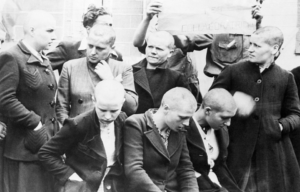Horizontal Collaboration: How Traitors Were Dealt With Following the Liberation of France
Horizontal Collaboration: How Traitors Were Dealt With Following the Liberation of France
When France was liberated in 1944, foreign press agencies were there to document the aftermath. Among the photos taken were of thousands of French women having their heads shaved. Without context, these images appear bizarre, as the majority of those subjected to the experience look on pensively while watched by a crowd of spectators. However, what they depict is a punishment for women accused of horizontal collaboration – collaborating with the German occupiers.
There were many ways to collaborate with the enemy, such as providing them with supplies, fighting alongside them or, under the right circumstances, becoming a double agent. The women in the aforementioned images were collaborators of a different kind, as they had relationships with German soldiers throughout France’s occupation.
German Occupation of France
German artillerymen march down the Champs-Élysées via the Arc de Triomphe in Paris, following the taking the city, July 1940. (Photo Credit: Hulton Archive / Getty Images)
France was invaded by German forces in May 1940 and defeated within a month, forcing an armistice between delegates from both countries. This marked France’s official surrender, and divided the nation into two zones: the German-occupied north and the French-controlled south, which was known as Vichy France.
Marshal Henri-Philippe Pétain was the authoritarian figurehead for Vichy France, where he acted in line with Germany, leading to tens of thousands of Jewish citizens being expelled from the region during this time. Some sources claim he’d hoped to act as a mediator between France and the Axis powers, to both keep German troops out of Vichy and to aid the French Resistance.
It wasn’t until November 1942 that German troops took Vichy, in retaliation for the involvement of Free French forces in North Africa. According to Germany, the acts committed by the French forces in the region had violated the armistice agreement that had been signed over two years prior.
Horizontal collaboration
Frenchmen cutting off the hair of a woman accused of horizontal collaboration. (Photo Credit: Fred Ramage / Keystone / Getty Images)
During the German occupation of France, there were many women who began relationships with enemy soldiers. Many of those who wound up with Germans were young mothers whose French husbands were in prisoner of war (POW) camps. The only way they could support themselves and their children was to enter into these relationships.
Many women, particularly in Paris, were forced into clubs to have relations with German soldiers for money. They were so popular that German and French officials worked together to regulate these establishments and build new ones, forcing even more women into this line of work. On occasion, some were even kidnapped from rural areas and brought to larger cities.
While many French and German relationships were forced, there were some that were based on a romantic connection. Many photos were taken from German POWs, which clearly showed them with their French girlfriends or wives during the the Second World War.
Whether the relationships were optional or forced, they were considered horizontal collaboration and something the women were heavily persecuted for at the end of the conflict






Comments
Post a Comment